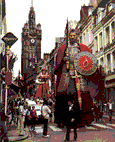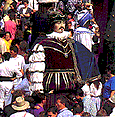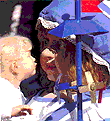Les
Gayants de
Douai
- city giants City mascots since 1530 In 1530, following another defeat of the French, a bigger
and better pageant was ordered by the Spanish rulers of
Flanders - and the town's Guild of basket-makers made a
float with a wickerwork giant called "GAYANT", the Picardy
dialect form of the French word "géant". The
following year, the guild of fruiterers made him a giant
wife: Madame Gayant ("Marie Cagenon").
Back to
top Controversial Gayants 18th century They reappeared in 1801, dressed as ordinary people in
the fashions of the time - apart from the warrior, M.
Gayant. By today's standards, most of these giants were quite
small, and could be carried by one man.

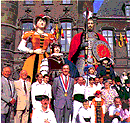
The family group - all the giants
outside the Town Hall, with the local mayor.
Douai's giants started as part of celebrations of
French defeats - the town was then part of Flanders. The
Count of Flanders narrowly escaped capture during an attack
by a French armed gang in 1479. Douai started an annual
festival each June in honour of the town's patron St.
Maurand who was supposed to have helped.
Douai became a French town in 1667, and the Bishop of
Arras ordered a new festival on July 6th to celebrate the
French victory. He cancelled the old pageant because it
celebrated a French defeat, and banned the gayants because
they were too profane - their procession by now included
devils and a dragon!
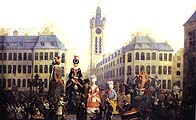
Famous local artist Louis Watteau painted the revived giants
parade in 1780 (or 1781)
They were revived in 1780, only to be banned in 1792 because
the atheist French
Revolution disapproved of religious processions, and
said the Gayants portrayed aristocrats (see Watteau's
painting, left.).
Back to
top
|
Bigger and better gayants since 1821 |
||
|
|
||
|
Following Napoleon's defeat in 1815 and the restoration
of the Bourbon monarchy, the gayants received the costumes
familiar to us today. They were destroyed during the German
occupation of the town in each of the two world wars, and
each time rebuilt. Each year on the Sunday after the 5th
July, Monsieur and Madame Gayant are joined in procession
round the town by their children: Jacquot, Fillon and
Binbin; by the figures of the "Wheel of Fortune", and by a
"fool" riding a hobbyhorse. |
||
|
How the giants work. |
|
|
|
Other
Places to visit: |
|
|
Background information |
|
|
|
|
|
